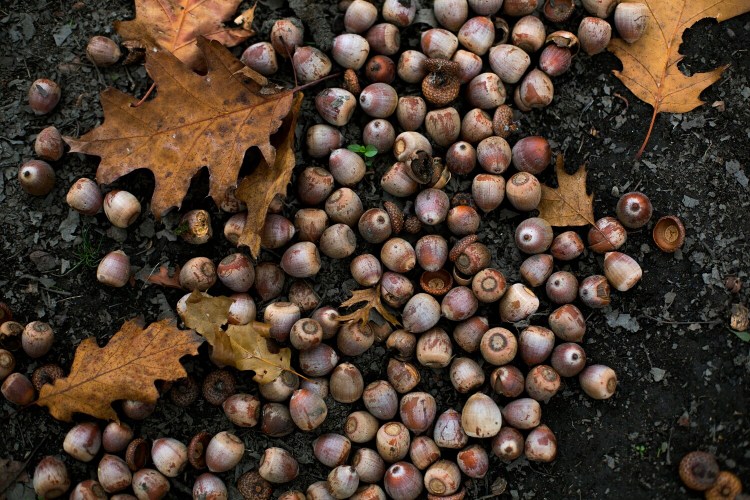Ping! The sharp metallic sound made me both jump and cringe at the same time as an acorn bounced off the shooting rail of my ladder stand and continued its descent to the forest floor. Loud and unnatural, it was not a sound I wanted the deer to hear, but tried to console myself that it was probably not so foreign or unusual to them, at least this fall, and it was part of the potential risk for setting up where I had.
Research has shown there are few if any natural foods deer prefer more than acorns, and while they can be a boom for both hunter and hunted, they can also be a bane for the latter, at least when they occur in abundance, as was the case over much of Maine where oaks occur. Oaks are generally lumped into two different groups: red (or black) and white. Maine is dominated by red oaks, though white oaks are locally sporadic in some parts of southwestern Maine. Species in each group differ in several ways, the most pronounced being how they produce acorns.
White oak acorns mature in one year, which makes them a more reliable source of mast, given favorable growing conditions. They also tend to drop early and over a relatively short time, meaning a short term but very attractive food source for deer. Their attraction is further enhanced by being low in tannins, which makes the smaller white oak acorns sweeter. If you’re lucky enough to live near a grove, or even a few large white oaks, it can be a great place to ambush deer, particularly during bow season.

Deer love to eat acorns. Shutterstock
Red oak acorns, on the other hand, take two years to mature. That means one year could be a boom and the next a bust, again depending on growing conditions. Prime conditions during an off year mean some nuts will still be hitting the ground. A late frost, drought or an infestation of browntail moths could reduce the crop during an expected high-yield year. Either way, the red oak’s two-year cycle is less consistent, but provides a good hedge against all-out mast crop failure during one bad year. Red oak acorns are also larger, drop later and over a longer period, making them available longer. And though they’re a tad more bitter, they’re also higher in fats and carbohydrates. Regardless, deer relish them.
Unfortunately, there can sometimes be too much of a good thing, at least from a hunter’s perspective. An abundant, widespread mast crop means deer don’t have to travel as far and wide to find food, making them less vulnerable to hunters. The rub then becomes finding a way to take advantage of the bounty.
I’m fortunate in that oaks are patchily distributed in the woods I hunt, which makes those patches hotspots for deer activity. I simply need to find the best producers, which are typically the largest, oldest trees.
It’s a different story where hardwoods dominate the landscape. Then it becomes a matter of which oaks might provide better odds. Fortunately, you need only apply the same logic you would during an absence in acorns. Find places where that abundant food source is easiest to access with the least risk. Look at the landscape, cover and terrain and find where the nuts occur along the path of least resistance, or closest to thick bedding cover.
Or, if you’re a mobile hunter, get up on the oak ridges and still-hunt. Hardwood-dominated forests tend to be more open, offering far greater long-range visibility. You can slip along, stopping frequently to glass and listen. Try to stay below the ridge line so as not to silhouette yourself, but don’t be afraid to peak over the other side now and then.
Based on the first couple weeks of the regular firearms season, Maine hunters haven’t had too much trouble competing with acorns. But if the sun sets on the last day of the season and your tag still isn’t filled, you can take some solace in knowing with all the acorns around this year the deer that survived should be in great condition and have a much better shot at making it through winter, regardless of how cold or snowy it gets. So there will be that many more around next year.
Bob Humphrey is a freelance writer and Registered Maine Guide who lives in Pownal. He can be reached at:
bhunt@maine.rr.com
Copy the Story LinkSend questions/comments to the editors.



Success. Please wait for the page to reload. If the page does not reload within 5 seconds, please refresh the page.
Enter your email and password to access comments.
Hi, to comment on stories you must . This profile is in addition to your subscription and website login.
Already have a commenting profile? .
Invalid username/password.
Please check your email to confirm and complete your registration.
Only subscribers are eligible to post comments. Please subscribe or login first for digital access. Here’s why.
Use the form below to reset your password. When you've submitted your account email, we will send an email with a reset code.